This matchup features two 2014 draft prospects in Oklahoma cornerback Aaron Colvin and Texas Tech wide receiver Eric Ward.
The early part of the first quarter was relatively uneventful for both. Red Raiders quarterback Seth Doege (an undrafted free agent signing of the Falcons) never really looked the way of Ward early on. The Sooners varied their pre-snap looks on Ward, with a mix of press and off coverage looks given to Doege. Colvin did make a tackle at the line of scrimmage after sneaking down from the outside on a blitz and coming free. With Colvin in off coverage, Texas Tech wants Ward on their offensive staple: the jailbreak screen.
The play design is self-explanatory as drawn up. Ward is taught to take one sharp step forward before turning back to the inside. He bellies back towards the quarterback in order to generate forward momentum as he makes the catch. The three interior lineman are taking their first steps backward to entice the interior pass rushers up the field and after the quarterback. They then swim past the tackles and get downfield. The green circle is where Doege wants to get the ball to Ward, where he can turn up field and follow a wall of blockers.
In order to make this play before getting sealed by the left guard, Aaron Colvin must anticipate it pre-snap and recognize it as soon as Ward breaks back to the inside. No defense goes into a game against Texas Tech without a clear plan for the jailbreak screen and intensive tape study on it. Oklahoma found this out the hard way in 2011. Ward is only one step out of his break in this shot, and Colvin has already planted and broke on the play.
This play fails because of a terrific play made by the defensive end (since graduated R.J. Washington) to deflect the pass into the waiting hands of a teammate. That’s not the point here though. On this occasion, it’s a testament to Colvin’s understanding of the gameplan. Texas Tech wants to nickel and dime you down the field with a quarterback who isn’t suited to consistently threaten over the top. When Colvin is in off coverage, he must be on his toes to anticipate plays where Doege can get the ball out quickly to Ward. He certainly did that on this occasion. That blur you see heading into the midsection of Ward is Colvin breaking on the ball well before the left guard can reach him.
Colvin’s hit knocked Ward out of the game for multiple plays. Colvin did give up a first down on a hook route to his replacement just a few plays later, though. Late in the first quarter on a second down with three yards to gain, the Red Raiders attempt a slant to Ward. Again, Colvin breaks on the ball quickly and a poor throw gives Ward no chance to make the play.
Early in the second quarter, Doege tests Colvin with a deep ball to Ward. Colvin is in press man coverage and keeps Ward from gaining separation by using his hands. Unfortunately, he keeps his hands on Ward too long and gets called for defensive pass interference. The call was borderline at best as Ward has an outstretched hand on Colvin as well. The take home point being the lack of top end speed in Ward to truly test Colvin on the nine route. Knowing he can run with Ward should allow Colvin the confidence to continue to play an aggressive style.
On the next play, the Red Raiders target Ward again. Doege mistimes his throw on a deep comeback route and frustration has clearly set in for Eric Ward.
Ward finally gets the better of Colvin in the middle of the second quarter on a simple crossing route. Ward has a 23 pound advantage on Colvin and finally makes use of it, outmuscling him before his break and separating away from him to get into the middle of the defense. Ward extends out to catch the ball well but doesn’t get much after the catch.
It’s at the end of the second quarter when Colvin makes a game-changing play.
Oklahoma defensive coordinator Mike Stoops has a cornerback blitz called up for Colvin. He’s going to inch his way to the inside pre-snap.
Seth Doege has spotted it before the ball is snapped and anticipates the blitz the whole way. He and Eric Ward are on the same page and revert to a hot route to take advantage of the blitzing Colvin.
As Doege releases the ball, Colvin times his jump to get his hands into the passing lane. He actually snags the ball right out of the air for an incredible interception. It’s a tremendous showing of quick reactions and ball skills. For Colvin to bring this ball down from such a short distance is quite remarkable. He halts the Texas Tech drive and allows Oklahoma to tack on three points before the half by creating a turnover out of nothing.
With only seconds left in the half, Doege looks for a hopeful deep ball to Eric Ward. Aaron Colvin keeps deep leverage on him the whole way and earns an offensive pass interference call by keeping his position over the top.
Early on in the third quarter, the Red Raiders look for Ward on a hook route to pick up the necessary five yards on third down. Colvin shows off man before walking up tighter to Ward pre-snap. He gets his hands into the frame of Ward right away and doesn’t allow him any separation the whole way. Doege’s pass is nowhere near, and Colvin gets the best of Ward once more. The Texas Tech offense’s inability to threaten Aaron Colvin over the top would come back to bite them again soon after.
It’s important to know what Texas Tech is anticipating with this play call: man coverage. They’ve seen it all game long, and Oklahoma has been highly effective with it. When Seth Doege sees Aaron Colvin seven yards off pre-snap, he’s probably thinking he already has this pass completed. Eric Ward should have all the space he needs on a square in to get an easy reception and pick up yards after the catch. Notice the yard line Colvin is starting on, the 42.
Now notice how far Colvin has dropped while reading the play, a yard at the most. Doege and Ward’s inability to test Colvin over the top has him sitting on Ward’s routes and breaking sharply on the ball. It doesn’t help that Doege is staring down his receiver the whole way.
Doege’s inability to place this ball with a semblance of accuracy compounds the fact that Colvin is onto this route from the get-go. As it arrives, Colvin disrupts the catch point and deflects the ball in the air. It lands into the waiting hands of the safety, who brings it all the way back for six points. What should have been a routine completion for the Red Raiders turned into a disaster that surely ended their hopes on the day.
Ward and Colvin had a quiet remainder of the game before Colvin was pulled with five minutes remaining. In the end, Ward pulled down three balls for a total of 20 yards. It was his least productive game of the season, which says a lot about the job Aaron Colvin did on him all game long. I expected Eric Ward to be able to use his size and strength advantage to bully Colvin off the top of his routes and create enough separation to bring down numerous receptions. For whatever reason, that wasn’t the case. When Colvin got his hands into the frame of Ward he actually got the best of the receiver. As I’ve already stated, it all came down to Colvin’s aggressiveness. He was honed in on the gameplan and unthreatened by Ward’s ability to get beyond him. This allowed him to play on his toes and anticipate the short passes the Red Raiders tried to complete in front of him. Aaron Colvin made the biggest plays of the game for the Sooners defense and punished poor play from the Texas Tech offense on multiple occasions. In the battle of Aaron Colvin vs. Eric Ward, the cornerback won decisively.
Originally published at DetroitLionsDraft.com: Draft Matchup: Aaron Colvin vs. Eric Ward


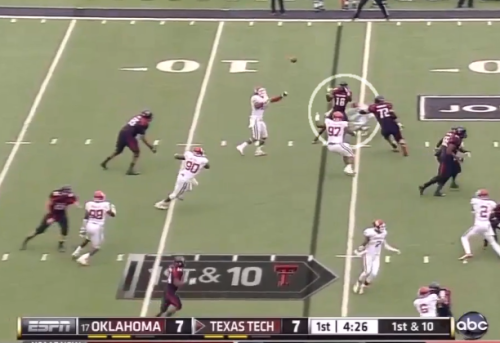
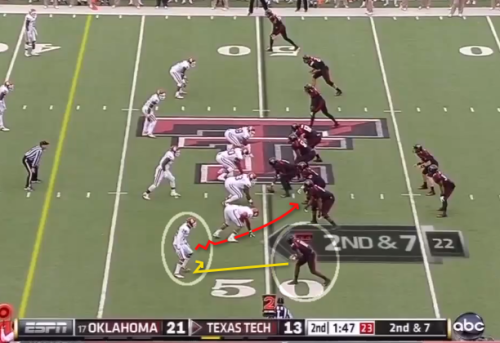

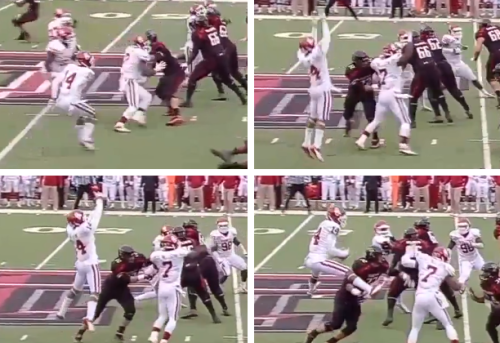

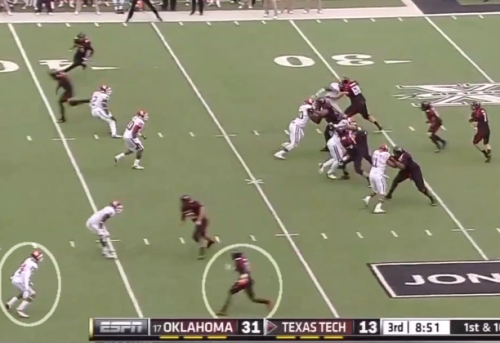
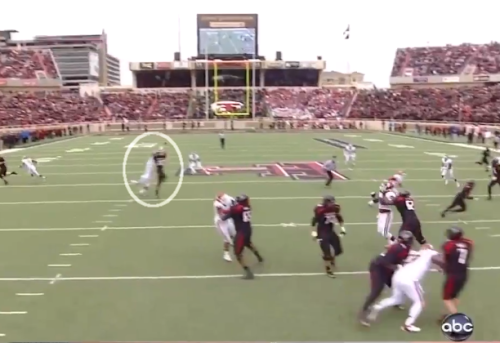
Leave a comment